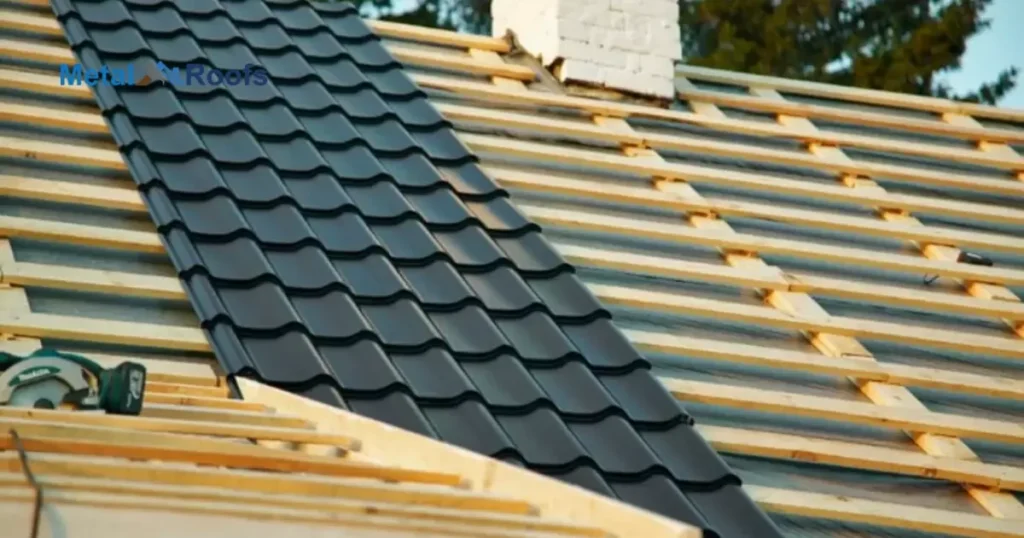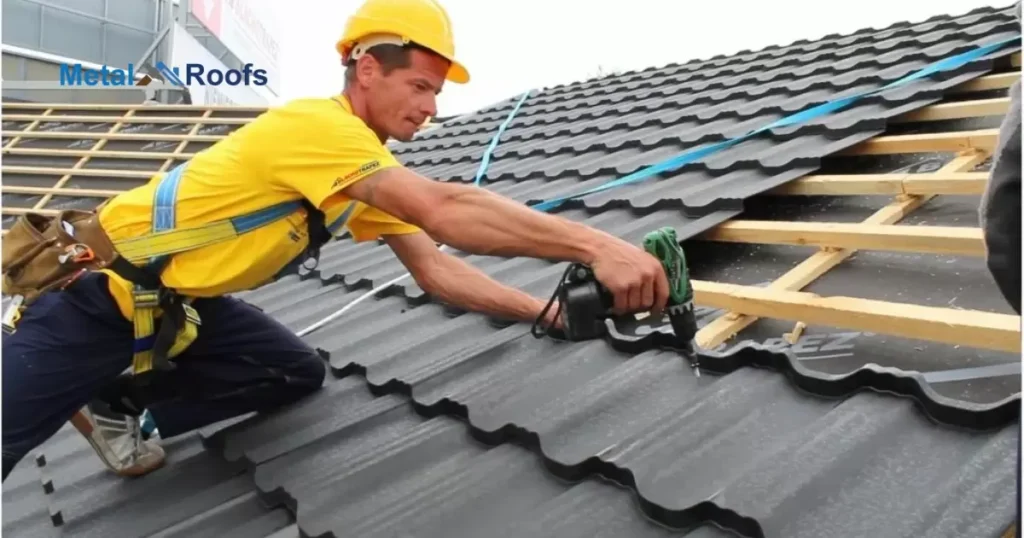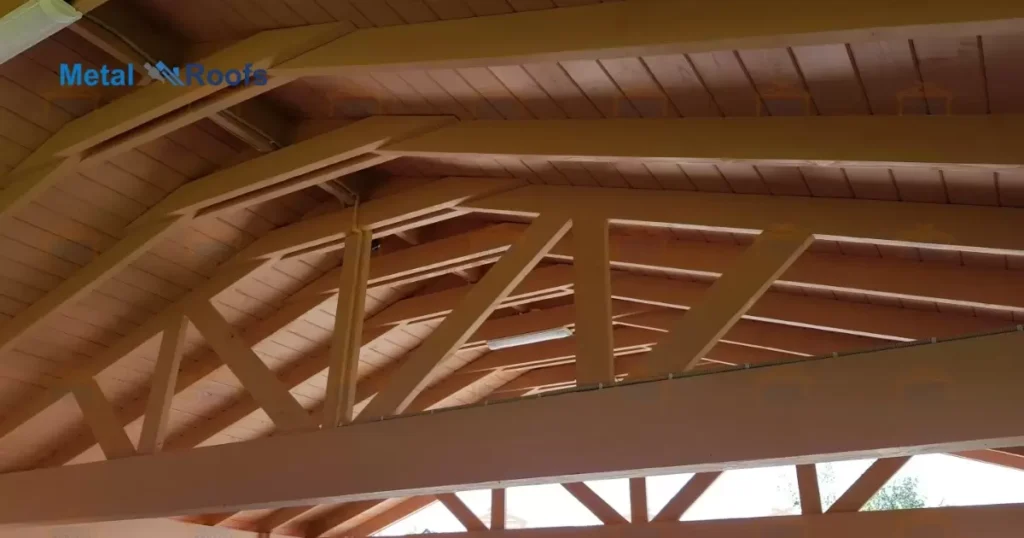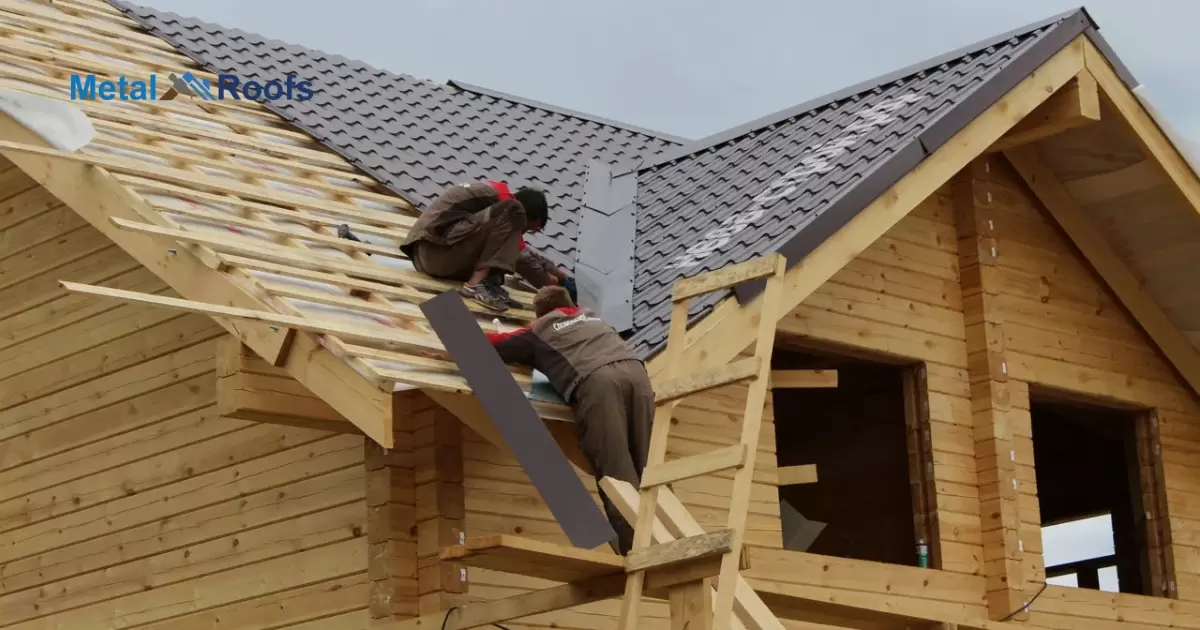Metal roofing can be installed directly onto plywood decking to create a durable, long-lasting roof proper fasteners and underlayment should be used to prevent issues like condensation buildup or roof leaks that could damage the plywood over time.
Metal roofs stand tough against weathering. Their sleek look graces buildings worldwide. Installing them involves key choices. One is whether laying metal roofing straight atop plywood can work. If done right, the roof will endure. If wrong, trouble looms.
Plywood offers an affordable and simple decking option. Yet moisture sits atop non-breathable wood. Trapped water causes rot. Also, plywood lacks robustness for heavy roofing. Still, with careful sealing and quality fasteners, metal applied directly on plywood can perform.
Key Takeaway
- Use moisture barriers and underlayment to protect plywood
- Quality fasteners are needed to firmly anchor to plywood
- Seal all plywood edges and joints thoroughly
- With proper installation, metal/plywood roofs can endure
Steps For Installing Metal Roofing Over Plywood
To install metal roofing over plywood, ensure the deck is sturdy. However, be aware that metal roofs interfere with cell phone reception. Then, apply roofing felt or synthetic underlayment to protect against moisture. Secure it properly.
Then, carefully position the metal roofing panels according to the manufacturer’s instructions. Use screws or nails to attach the panels to the plywood deck, ensuring proper spacing and overlap. Install flashing around roof penetrations and edges to prevent leaks.
Inspect And Repair The Plywood Before Installing Metal Roofing
| Task | Description |
| Inspect Plywood | Check for signs of damage, rot, or warping. Replace any compromised sections. |
| Repair Plywood | Fix any loose or damaged plywood panels. Ensure a smooth and even surface. |
Before installing metal roofing, it’s crucial to inspect and repair the plywood beneath it. Start by checking the plywood for any signs of damage, such as rot, cracks, or warping. Repair any damaged areas by replacing the affected plywood sheets.
Ensure that the plywood is securely fastened to the roof rafters or trusses. Use appropriate screws or nails to reattach any loose or sagging sections. Next, apply a suitable underlayment over the plywood to provide an additional layer of protection against moisture.
Protective Underlayment Be Applied Over The Plywood Before Installing Metal Roofing

Before installing metal roofing, it’s crucial to apply a protective underlayment over the plywood decking. This underlayment shields against moisture and prevents leaks, ensuring a durable roof. Choose roofing felt or synthetic underlayment for this purpose.
These materials act as a barrier, safeguarding your home from potential water damage. Following this step-by-step process helps maintain the integrity of the roof and extends its lifespan. It’s a simple yet essential measure in metal roofing installation.
Recommended Plywood Thickness For Installing Metal Roofing
To ensure a sturdy base for metal roofing, use plywood with a thickness of at least 1/2 inch. This provides ample support for the roofing material and helps prevent sagging or warping over time. Securely fasten the plywood to the roof rafters or trusses to ensure stability and durability.
Once the plywood is in place, install a suitable underlayment such as roofing felt or synthetic material. This additional layer helps protect against moisture and enhances the roof’s weatherproofing. With the proper plywood thickness and underlayment, you can proceed to install the metal roofing panels according to the manufacturer’s instructions, ensuring a reliable and long-lasting roofing system for your home or building.
Prevented When Installing Metal Roofing Over Plywood
When installing metal roofing over plywood, avoid direct attachment. Start with a solid plywood deck, about ½ inch thick. An underlayment, like roofing felt or synthetic material. Secure the metal roofing panels according to manufacturer guidelines.
Use screws or fasteners to prevent movement. Proper flashing around edges and penetrations is crucial. Trim pieces provide a finished appearance and extra protection. Following these steps ensures a durable and weather-resistant installation.
Benefits Of Using Underlayment For Metal Roofing
Using underlayment for metal roofing offers several benefits.
Weather Protection: Underlayment acts as an additional barrier against water infiltration, preventing leaks and protecting the roof deck from moisture damage. This is particularly important in areas prone to heavy rainfall or snow accumulation.
Condensation Control: Metal roofs can be prone to condensation buildup underneath due to temperature differentials between the interior and exterior of the building. Underlayment with vapor barriers can help mitigate this issue by preventing moisture from reaching the roof deck.
Noise Reduction: Metal roofing can amplify the sound of rain, hail, and other external disturbances. Underlayment can dampen these noises, providing a quieter indoor environment.
Temperature Regulation: Underlayment with reflective properties can help to reduce heat transfer, keeping the interior of the building cooler in hot climates and potentially lowering energy costs associated with air conditioning.
Protection Against Corrosion: Some underlayment materials offer additional protection against corrosion by creating a barrier between the metal roof and any corrosive elements present in the environment.
Improved Roof Longevity: Providing an extra layer of protection, underlayment can extend the lifespan of the metal roofing system by reducing the likelihood of damage from environmental factors and improving overall durability.
Why Is Underlayment Important For A Metal Roofing System?
Underlayment is crucial for a metal roof. It acts as a barrier, stopping water from seeping into the plywood decking. Without it, moisture can lead to rot and damage. Underlayment also adds an extra layer of protection against leaks. It helps to create a watertight seal between the roofing panels and the deck.
Proper installation of underlayment ensures the longevity and durability of the metal roofing system. It’s an essential step in the process, providing peace of mind for homeowners and protection for their investment.
Potential Problems Of Not Using Underlayment For Metal Roofing

Not using underlayment with metal roofing invites trouble. Skipping this step risks moisture seeping through. Without underlayment, water can penetrate the plywood. This leads to rot and damage over time.
Underlayment acts as an extra barrier. It shields against wind-driven rain and snow. Without it, leaks become more likely. In essence, underlayment protects your investment. It’s a crucial layer for a sturdy, long-lasting roof.
Key Maintenance Tasks For Ensuring The Durability Of Metal Roofing Over Plywood
To ensure the durability of metal roofing over plywood, there are key maintenance tasks to follow. Firstly, ensure the plywood decking is solid and securely fastened to the roof structure. Secondly, apply a suitable underlayment over the plywood to provide an additional layer of protection against moisture.
Then, install the metal roofing panels according to the manufacturer’s instructions, ensuring proper spacing and overlap. Next, install flashing around roof penetrations and along edges to direct water away and prevent leaks. Finally, regularly inspect the roof for any signs of damage or wear and promptly address any issues to maintain its longevity.
Important Considerations For Installing Metal Roofing Over Osb
When installing metal roofing over OSB, ensure the OSB decking is at least ½ inch thick. This sturdy base provides support for the metal panels. Use roofing felt or synthetic underlayment to add an extra layer of protection against moisture. Securely fasten the metal roofing panels to the OSB decking following manufacturer guidelines.
Proper spacing and overlap of the panels are crucial for a watertight seal. Install flashing around roof penetrations and trim along edges for added protection and a finished look. Following these steps ensures a durable and weather-resistant metal roofing installation over OSB decking.
Roof Underlayment Be Used For A Metal Roofing System
When installing a metal roof, it’s crucial to use a roof underlayment. The underlayment acts as a barrier against moisture, protecting your home from leaks. It provides an extra layer of defense between the metal panels and the roof decking. Without underlayment, water could seep through gaps in the metal and cause damage to the structure.
Roof underlayment also helps to prevent condensation buildup in the attic. It allows air to circulate while blocking moisture from entering the living space. This helps to maintain a comfortable indoor environment and prolong the life of your roof. Overall, using a roof underlayment is essential for ensuring the durability and longevity of your metal roofing system.
Sheathing For Metal Roof
When installing a metal roof, it’s vital to have a sturdy sheathing. Plywood or OSB is commonly used for this purpose. The sheathing provides a solid base for the metal panels and helps prevent moisture issues. Make sure the sheathing is at least ½ inch thick and securely fastened to the roof rafters or trusses.
Over the sheathing, apply a suitable underlayment like roofing felt or synthetic material for added protection against leaks. Then, carefully install the metal roofing panels according to the manufacturer’s instructions, ensuring proper spacing and overlap.
Plywood Purlins Under Metal Roofing

When choosing between plywood and purlins for under metal roofing, it’s essential to consider the structure’s stability. Plywood provides a solid base for the metal sheets, ensuring a secure installation. Purlins, on the other hand, are horizontal beams that offer support for the roofing but may require additional materials for proper attachment.
Plywood offers versatility and ease of installation, making it a popular choice for residential roofing projects. Purlins, though sturdy, may require more labor and materials to install correctly. Ultimately, the decision between plywood and purlins depends on factors such as budget, building design, and local building codes.
Frequently Asked Questions
Should I put anything under a metal roof?
When installing a metal roof, use plywood as a solid base and add underlayment for moisture protection. Flashing and trim are also crucial for durability and weather resistance.
Can metal roofing be installed without sheathing?
No, metal roofing needs sheathing for support and protection. Skipping it risks leaks and structural issues. Follow proper installation guidelines for a strong roof.
Do you need wood under metal roof?
Yes, you need wood under a metal roof. Plywood provides a sturdy base for installation and prevents moisture issues. Underlayment adds extra protection against leaks.
Conclusion
Installing metal roofs directly onto plywood can work well. It presents challenges though. Moisture and durability issues must be addressed. With careful installation and quality materials, roofs will last decades. Pay attention to details like underlayment and fastener type.
Plywood requires extra care for metal roofing. But it offers affordability and availability. Correct construction techniques can make plywood decks robust and long-lasting. A quality metal roof on plywood will protect buildings for years. With informed decisions, metal and plywood can partner to deliver durable shelter.











